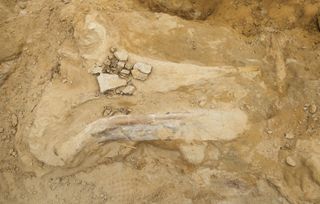Triceratops Skull, Skeleton Discovered Together in Rare Find

A construction crew in Colorado was forced to stop work on a new fire and police station recently when one of the workers hit something unusual: a pair of bones from a Triceratops that lived more than 65 million years ago.
The fossils were found by the construction crew in Thornton, Colorado, on Aug. 25.
More bones have since been excavated by Joe Sertich, a vertebrate paleontologist from the Denver Museum of Nature & Science who is overseeing the excavation, and his team. The crew, which has been working since Aug. 30, has discovered major parts of the skull, including parts of the lower jaw and mouth, both of the horns above the eyes, and portions of the braincase. But in addition, the team has also found bones from the rest of the Triceratops' body, including vertebrae, ribs and a shoulder blade, Sertich told Live Science in an email. [Tiny & Old: Images of 'Triceratops' Ancestors]
"It's pretty unusual to get Triceratops skulls and skeletons together. And that's one of the things that makes this an exciting and somewhat rare find," Sertich told Live Science.
Triceratops was a three-horned herbivore that resembled a rhino equipped with horns above its eyes and a bone in the shape of Queen Elizabeth I's collar. These animals once roamed the dip of the Denver Basin, before they were wiped out along with all other nonavian dinosaurs in the Cretaceous-Tertiary extinction event 65 million years ago.
While hundreds of Triceratops skulls have been found in Montana and the Dakotas, usually the skulls are found without any accompanying bones from the rest of the body, according to Sertich. Only three other Triceratops skulls have been found before in the Denver Basin. And of those three skulls, just one — uncovered in the late 1980s near Briggsdale, Colorado — was discovered along with a few other bones from the animal's skeleton.
"Triceratops are notorious for losing their heads," Sertich said. This, thankfully, is not evidence of a prehistoric decapitation scheme. Rather, after the dinosaurs' deaths, rivers and scavengers generally dispersed the smaller bones of the body, while the more-robust skull bones — fused together in a large block — remained, according to Sertich.
Sign up for the Live Science daily newsletter now
Get the world’s most fascinating discoveries delivered straight to your inbox.
On Sept. 1, the team transported the bones of the recent find back to the Denver Museum of Nature & Science, where the fossils were cleaned and put on display, according to a video on the museum's Facebook page.
Sertich said he is grateful to the construction crewmembers for recognizing the extraordinary nature of the hard objects that blocked their way. When considering how many other fossilized bones may have been destroyed during other construction projects, Sertich said, "It breaks your heart."
Original article on Live Science.


